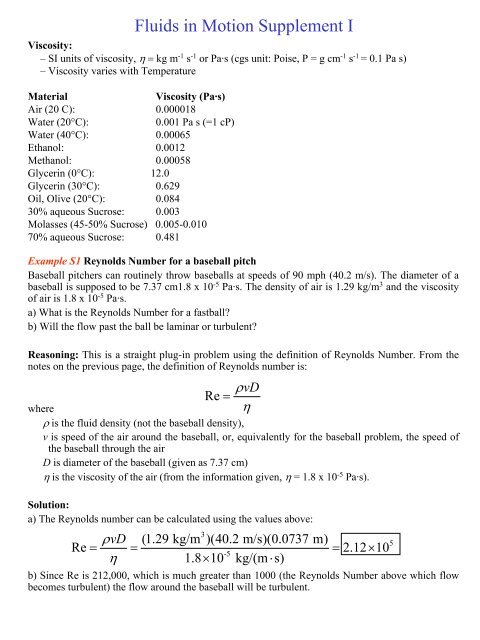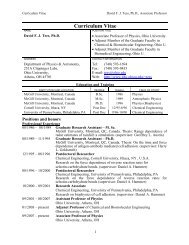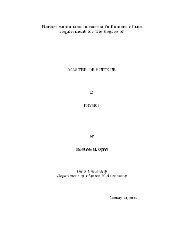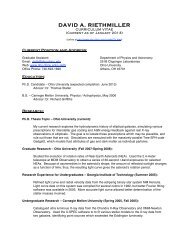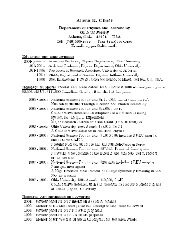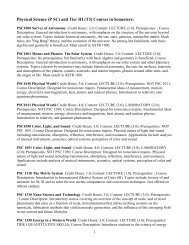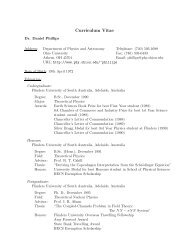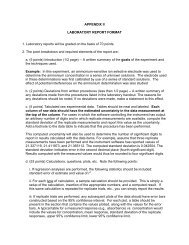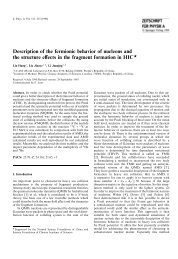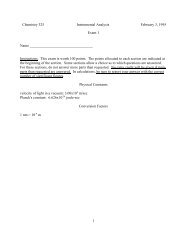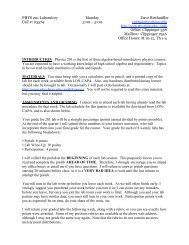Fluids in Motion Supplement I
Fluids in Motion Supplement I
Fluids in Motion Supplement I
You also want an ePaper? Increase the reach of your titles
YUMPU automatically turns print PDFs into web optimized ePapers that Google loves.
<strong>Fluids</strong> <strong>in</strong> <strong>Motion</strong> <strong>Supplement</strong> I<br />
Viscosity:<br />
– SI units of viscosity, η = kg m -1 s -1 or Pa·s (cgs unit: Poise, P = g cm -1 s -1 = 0.1 Pa s)<br />
– Viscosity varies with Temperature<br />
Material<br />
Viscosity (Pa·s)<br />
Air (20 C): 0.000018<br />
Water (20°C):<br />
0.001 Pa s (=1 cP)<br />
Water (40°C): 0.00065<br />
Ethanol: 0.0012<br />
Methanol: 0.00058<br />
Glycer<strong>in</strong> (0°C): 12.0<br />
Glycer<strong>in</strong> (30°C): 0.629<br />
Oil, Olive (20°C): 0.084<br />
30% aqueous Sucrose: 0.003<br />
Molasses (45-50% Sucrose) 0.005-0.010<br />
70% aqueous Sucrose: 0.481<br />
Example S1 Reynolds Number for a baseball pitch<br />
Baseball pitchers can rout<strong>in</strong>ely throw baseballs at speeds of 90 mph (40.2 m/s). The diameter of a<br />
baseball is supposed to be 7.37 cm1.8 x 10 -5 Pa·s. The density of air is 1.29 kg/m 3 and the viscosity<br />
of air is 1.8 x 10 -5 Pa·s.<br />
a) What is the Reynolds Number for a fastball?<br />
b) Will the flow past the ball be lam<strong>in</strong>ar or turbulent?<br />
Reason<strong>in</strong>g: This is a straight plug-<strong>in</strong> problem us<strong>in</strong>g the def<strong>in</strong>ition of Reynolds Number. From the<br />
notes on the previous page, the def<strong>in</strong>ition of Reynolds number is:<br />
ρvD<br />
Re =<br />
η<br />
where<br />
ρ is the fluid density (not the baseball density),<br />
v is speed of the air around the baseball, or, equivalently for the baseball problem, the speed of<br />
the baseball through the air<br />
D is diameter of the baseball (given as 7.37 cm)<br />
η is the viscosity of the air (from the <strong>in</strong>formation given, η = 1.8 x 10 -5 Pa·s).<br />
Solution:<br />
a) The Reynolds number can be calculated us<strong>in</strong>g the values above:<br />
3<br />
ρvD (1.29 kg/m )(40.2 m/s)(0.0737 m)<br />
Re = = = 2.12×<br />
10<br />
-5<br />
η<br />
1.8× 10 kg/(m ⋅s)<br />
b) S<strong>in</strong>ce Re is 212,000, which is much greater than 1000 (the Reynolds Number above which flow<br />
becomes turbulent) the flow around the baseball will be turbulent.<br />
5


